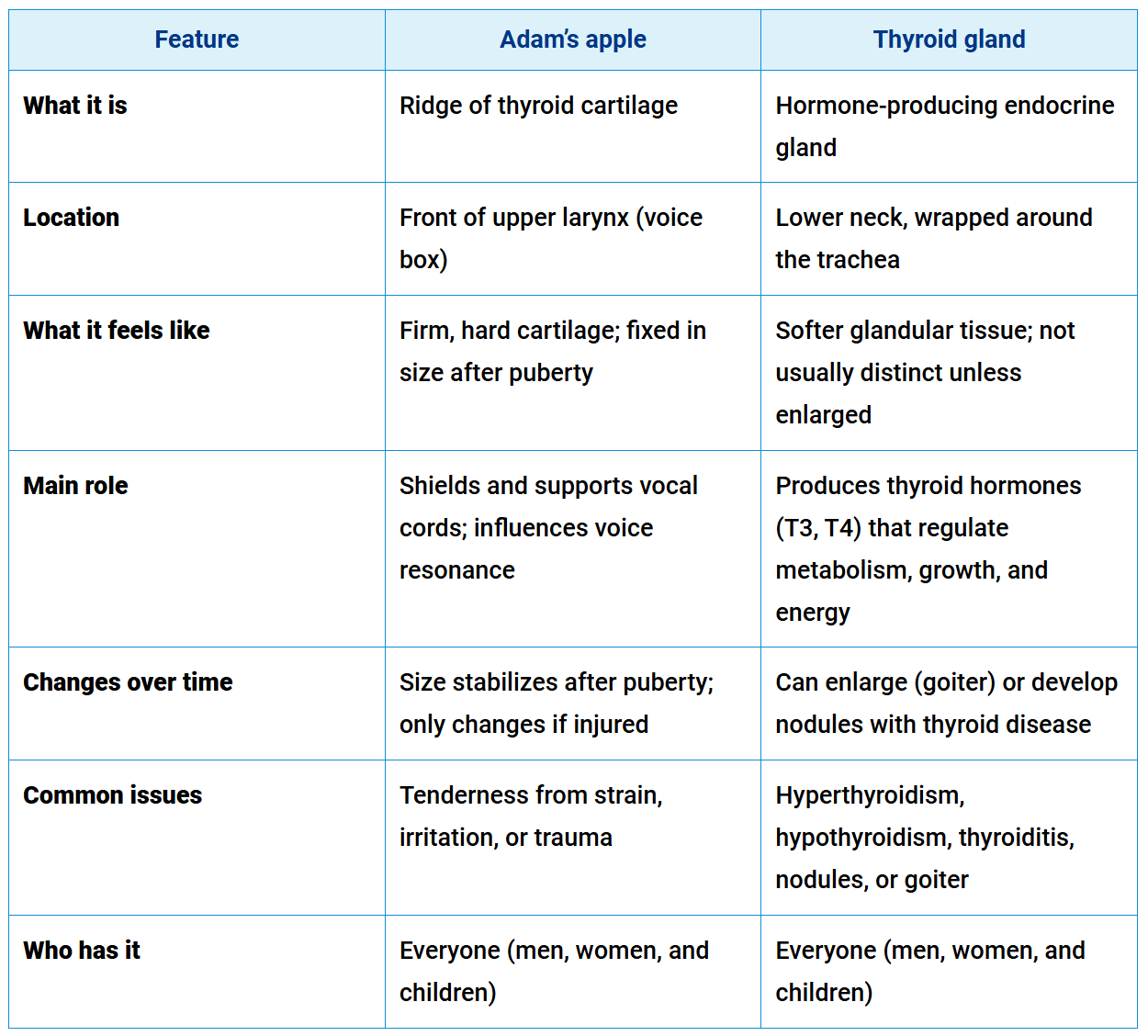Your Adam’s Apple — What It Is, What It Does, and Who Has One
Ever wondered what that bump in your throat does? Discover what the Adam's apple really is, why everyone has one, and when soreness could signal something more.
STORY AT-A-GLANCE
The Adam’s apple is the visible ridge of thyroid cartilage at the front of your larynx (voice box). Everyone has one, though its size and visibility vary by sex, hormones, body fat, and genetics
The Adam’s apple isn’t bone or muscle — it’s made of firm yet flexible hyaline cartilage, which helps shield the vocal cords and anchor muscles that control pitch and tone
During puberty, testosterone enlarges the larynx in many males, making the Adam’s apple more prominent and lowering the pitch of the voice. Females also experience laryngeal growth, but usually to a lesser degree
Its role goes beyond voice: the Adam’s apple helps protect the airway during swallowing by lifting the larynx so food and liquid go into the esophagus rather than the lungs
Pain or soreness in this area is rarely due to the cartilage itself but can stem from nearby structures. Common causes include muscle or throat tension, infections, thyroid disorders, acid reflux, or — in rare cases — laryngeal cancer
If you’ve ever noticed that bump in the middle of your throat and wondered what it’s doing there, you’re not alone. That’s your Adam’s apple, and despite all the mystery around it, it’s just a piece of cartilage on your voice box — a part of the structure that helps you talk, sing, or even laugh.
Some people have an Adam’s apple that sticks out, while others barely see theirs, making them wonder if they have one at all. But the truth is that everyone’s got one — it just looks different from person to person. The appearance of your Adam’s apple has more to do with hormones, body shape, and genetics.
What Is an Adam’s Apple, Exactly?
An Adam’s apple is the ridge you see — or feel — on the front of your throat where two identical plates of thyroid cartilage, called the laminae, meet.1 It sits just above your thyroid gland and in front of your vocal cords, which are inside your voice box, or larynx. Think of it as a piece of structural scaffolding that keeps one of your body’s most delicate instruments — the vocal cords — safe.2
The Adam’s apple is not made up of bone or muscle — It’s a type of cartilage called hyaline cartilage. This gives it a firm but flexible and resilient structure.3
What does the Adam’s apple look like? On the outside, the Adam’s apple appears as a small bump at the front of your throat. Beneath the surface, it’s formed by the two thyroid cartilage plates that meet at the front in a V-shaped angle, creating the ridge that you see or feel.
Where is the Adam’s apple located? If you want to find your Adam’s apple, place two fingers on the middle of your neck just below your chin. Swallow gently. You’ll feel your larynx rise and fall, and the firm ridge at the front is your Adam’s apple.
The angle at which the two cartilage plates meet determines how visible your Adam’s apple looks from the outside — A sharper angle creates a more noticeable bump, while a wider angle makes the ridge less obvious. As described by Kenhub, a learning platform that focuses on human anatomy:4
“In females, the laminae meet at an angle of approximately 120 degrees while in males, the angle is more acute at around 90 degrees. This smaller thyroid angle explains the more pronounced laryngeal prominence seen in males (the ‘Adam’s apple’), longer vocal cords, and lower-pitched voice in males.”
Your body fat also affects visibility, which is why some people have a clear protrusion while others don’t.
Why Is It Called ‘Adam’s Apple’?
The medical term for an Adam’s apple is laryngeal prominence, although some simply call it thyroid cartilage. But if you’re wondering how this body part earned its moniker, one of the more common explanations is quite interesting.5
The name is believed to have biblical origins — The term “Adam’s apple” is tied to the biblical story of Adam and Eve, in the book of Genesis. According to tradition, when Adam ate the forbidden fruit, a piece was said to have lodged in his throat, leaving a visible lump. While this is more legend than fact, the name stuck, and over time the throat bump became associated with that story.6
However, some say it was derived from “centuries of linguistic evolution and a bit of mistranslation” — The name was believed to have roots in early European and Arabic medical texts. In the 1600s, some Latin writings used fruit terms — like pomegranate — to describe the throat’s protrusion.
Arabic medical sources also compared this body part to a pomegranate — When these descriptions were translated into English, the imagery shifted, and over time the phrase “Adam’s apple” became the common term.7
So What Does the Adam’s Apple Do?
Your Adam’s apple isn’t what makes sound, but it’s a key part of the system that allows you to speak, sing, shout, or whisper. To give you a better idea, it’s important to know how your body produces sounds.
Sound begins when air from your lungs passes through the larynx — This causes your vocal cords to vibrate, like strings on an instrument. As the Cleveland Clinic explains:8
“When you breathe in (inhale) and breathe out (exhale), your vocal cords open so air can flow freely. When you speak, your vocal cords close by meeting in the middle of your exhaled airstream and vibrate. The vibration creates the sound of your voice.”
Your Adam’s apple isn’t just about voice — Its placement at the front of your throat gives it a second, equally important job: protection. The thyroid cartilage works like a protective frame, keeping your vocal cords safe from outside pressure and giving the muscles and ligaments inside a stable surface to pull against when adjusting pitch and tone. Without it, the delicate vocal cords and airway would be far more exposed to trauma.
Movement is another overlooked function — If you gently touch your throat while swallowing, you’ll feel the Adam’s apple rise and fall. This is your larynx lifting upward, a motion that helps close off the airway so food or drink goes down the esophagus instead of into your lungs. It’s a simple action, but it shows how the Adam’s apple participates in more than just sound — it’s part of the mechanical system that protects you every time you eat or drink.
In summary, the Adam’s apple serves three main roles — it frames and protects your vocal cords, it helps shape the depth and tone of your voice, and it contributes to airway safety during swallowing. Far from being just a cosmetic bump, it’s a small but important feature that makes both communication and safe breathing possible.
Does Everyone Have an Adam’s Apple (Including Women)?
Despite misconceptions, everyone has thyroid cartilage and, therefore, an Adam’s apple. The only difference is how prominent it appears. While most women have barely any protrusion on their neck, there are some with noticeable Adam’s apples — and this is perfectly normal.9
In men, puberty changes the thyroid cartilage — During puberty, a boy’s testosterone levels spike, which stimulates the growth of the cartilage. It causes the larynx to enlarge and thicken significantly. This enlargement not only results in a more visible Adam’s apple. And because the vocal cords also lengthen and thicken, they produce a lower pitch and deeper resonance. This is why boys often experience their voice “cracking” before it finally settles into a deeper register.
So why is the Adam’s apple in women not as prominent? Females also go through laryngeal changes, though these are usually less pronounced due to them having lower testosterone levels. This is why their Adam’s apple is less visible and their voices stay higher-pitched.10
Even if yours isn’t visible, it plays the same role in protecting your voice box — In fact, this spot is very sensitive, which is why pressing down on your Adam’s apple is uncomfortable and shouldn’t be done casually.11
Adam’s Apple vs. Thyroid Gland — What’s the Difference?
It’s common to mix up the Adam’s apple and the thyroid gland since they’re both located in the front of the neck. But one is structural cartilage, and the other is a hormone-producing gland.
Difference in location — While the Adam’s apple is the ridge of thyroid cartilage at the top of the larynx, the thyroid gland sits lower, closer to the collarbone.12 It’s a butterfly-shaped organ wrapped around the trachea, and helps regulate metabolism, growth, and energy.
One way to think about it is this — the Adam’s apple is like a shield, while the thyroid gland is like a regulator. The Adam’s apple has no hormonal role — it won’t affect your weight, metabolism, or energy. The thyroid gland, on the other hand, has no structural role in your voice — it won’t change how your voice sounds, but its health is essential for how your whole body functions. Here’s a side-by-side look:
This table makes it easy to see why the Adam’s apple and thyroid gland shouldn’t be confused. One gives structure and protection to your voice, the other controls key hormones that affect nearly every system in your body.
Is Adam’s Apple Pain Normal (and When Should I Worry)?
Pain or discomfort around the Adam’s apple can feel alarming because this area houses so many important structures, such as your larynx, thyroid gland, and several muscles that support neck movement and swallowing. Since the Adam’s apple itself is cartilage, it’s rarely the direct source of pain; however, soreness in this region often comes from nearby tissues.
Understanding the possible causes will help you figure out whether it’s a minor issue or something that requires medical care. The Hearty Soul lists some possible triggers for Adam’s apple pain:13
Muscle tension or tightness — The muscles in your neck help support posture and head movement, and several lie close to the thyroid cartilage. Hours spent working at a desk, repetitive head movements, or even jaw problems cause these muscles to tighten. When that happens, it may feel like the soreness is centered on your Adam’s apple.
Gentle stretches — like tilting your head up, turning side to side, or rolling your shoulders — will help ease tension. Regular breaks from sitting help too. For persistent stiffness, therapies such as massage, osteopathy, or acupuncture may provide relief.
Throat tension — Some people describe throat tension as a lump in the throat or a sense of tightness around the Adam’s apple. This can come with frequent swallowing, soreness, or tenderness in the neck. Triggers include stress, anxiety, allergies, postnasal drip, or overusing your voice, a condition known as muscle tension dysphonia.
Managing stress, avoiding irritants, or working with a speech therapist can help reduce throat tension. In some cases, medications or allergy treatments may be recommended by your healthcare provider.
Viral and bacterial infections — Conditions like the common cold, flu, strep throat, or even COVID-19 can inflame the tissues in your throat and voice box, leading to pain, swelling, and difficulty swallowing. Rest, hydration, and soothing remedies such as Manuka honey, bone broth, or throat lozenges often help mild infections resolve. Seek medical care if symptoms worsen, if you have a high fever, or if you struggle to swallow or breathe.
Thyroid disorders — Disorders like hypothyroidism, hyperthyroidism, or an enlarged thyroid (goiter) cause swelling, pressure, and soreness in the front of the neck. A large goiter can even affect swallowing or breathing.
If you suspect thyroid trouble, consult a healthcare provider. Blood tests such as TSH, free T4, and free T3 help reveal whether your thyroid is underactive, overactive, or inflamed. Treatment will depend on the specific condition.
Gastroesophageal reflux disease (GERD) — Acid reflux, when stomach contents flow back into the esophagus, can irritate tissues near the larynx. This sometimes causes soreness near the Adam’s apple, along with a burning sensation, cough, or difficulty swallowing.
Avoid common triggers like caffeine, alcohol, chocolate, and fatty meals. Eat smaller portions and remain upright after meals. If lifestyle changes aren’t enough, a doctor may prescribe medications such as proton pump inhibitors.
Laryngeal cancer — Though far less common, persistent Adam’s apple pain may be an early sign of laryngeal cancer, especially in people who smoke or consume heavy alcohol. This cancer develops in the voice box, which sits just behind the Adam’s apple, and may present with hoarseness, swallowing difficulties, or a lump in the neck.
Seek medical attention immediately if you have ongoing pain, unexplained voice changes, or a lump that doesn’t go away. Early diagnosis leads to better treatment outcomes.
Safety Checklist — When to Get Medical Help
Occasional mild soreness is often harmless, but persistent or severe symptoms should never be ignored. If you experience any of these telltale signs, consult a healthcare provider who can help pinpoint the cause so you can seek the right medical attention.14
Pain that persists or worsens over time
Difficulty swallowing
Shortness of breath
Wheezing and coughing
Fatigue
Excessive sweating
Frequently Asked Questions (FAQs) About the Adam’s Apple
Q: Can women have an Adam’s apple?
A: Yes. Everyone has thyroid cartilage, which forms the Adam’s apple. The difference is how prominent it looks. Genetics, body fat, and hormone levels affect visibility. In men, higher testosterone during puberty usually makes the cartilage grow more, while in women, the changes are subtler — but the structure is always there.
Q: Is a big Adam’s apple normal?
A: Variation in size is completely normal. Some people have a more prominent bump, while others barely notice theirs. Size alone isn’t a concern unless it changes over time, becomes painful, or is associated with other symptoms like difficulty swallowing.
Q: Why does my Adam’s apple click when I swallow?
A: The larynx naturally moves up and down during swallowing. As it shifts, the thyroid cartilage can make contact with nearby structures, producing a clicking sound. This is usually harmless. If the click is painful or comes with trouble swallowing, it’s worth seeing a clinician.
Q: Is the Adam’s apple part of the thyroid?
A: No. The Adam’s apple is the ridge of thyroid cartilage at the top of your larynx, while the thyroid gland is an endocrine organ that sits lower in the neck and regulates metabolism through hormone production. They sit close together but have completely different roles.
Q: Does everyone’s Adam’s apple move when swallowing?
A: Yes. The Adam’s apple moves because the larynx rises during a swallow, helping close off the airway so food and liquids go into the esophagus instead of the lungs.
Disclaimer: The entire contents of this website are based upon the opinions of Dr. Mercola, unless otherwise noted. Individual articles are based upon the opinions of the respective author, who retains copyright as marked.
The information on this website is not intended to replace a one-on-one relationship with a qualified health care professional and is not intended as medical advice. It is intended as a sharing of knowledge and information from the research and experience of Dr. Mercola and his community. Dr. Mercola encourages you to make your own health care decisions based upon your research and in partnership with a qualified health care professional. The subscription fee being requested is for access to the articles and information posted on this site, and is not being paid for any individual medical advice.
If you are pregnant, nursing, taking medication, or have a medical condition, consult your health care professional before using products based on this content.





